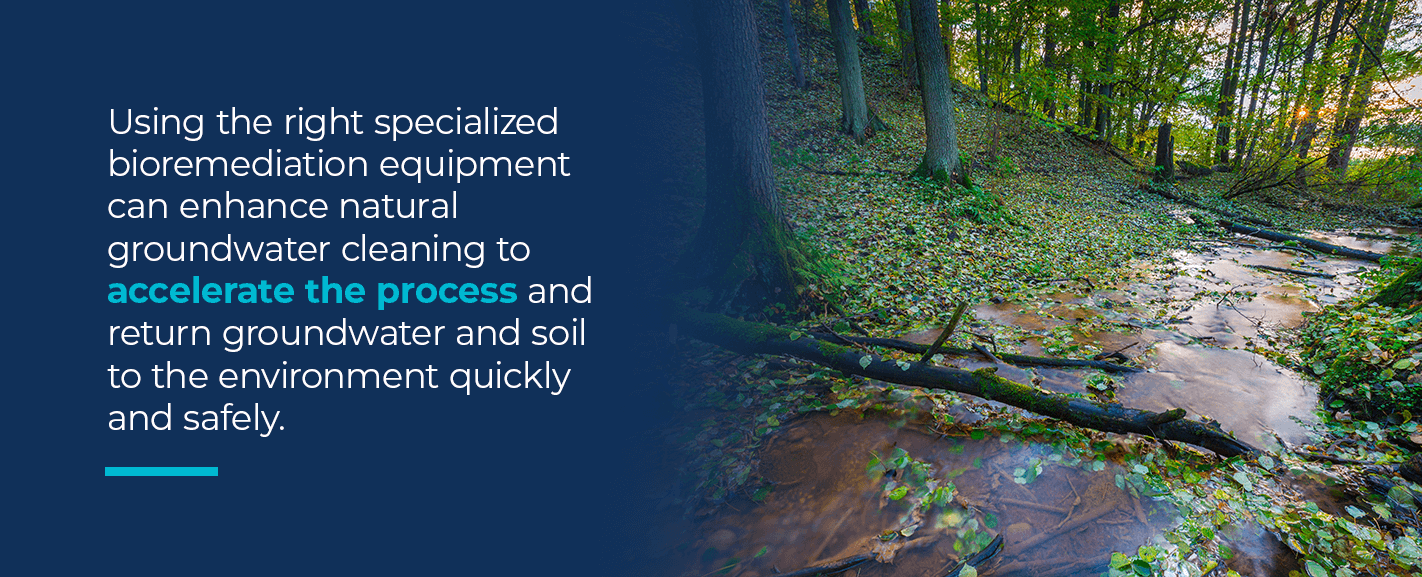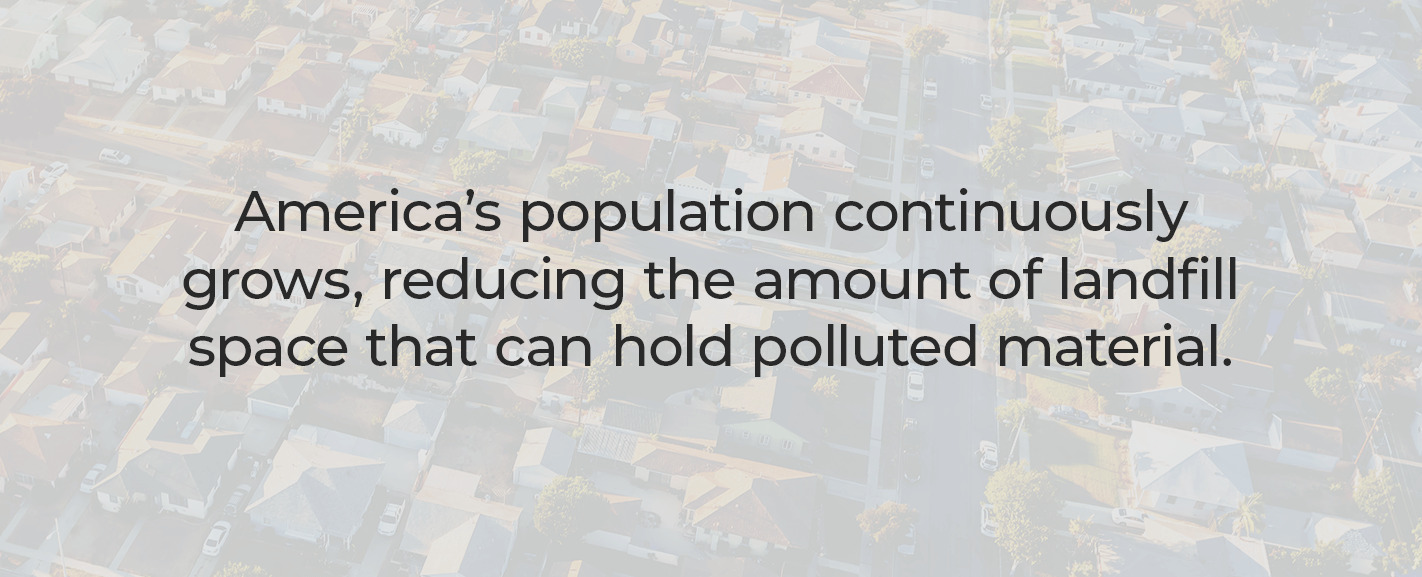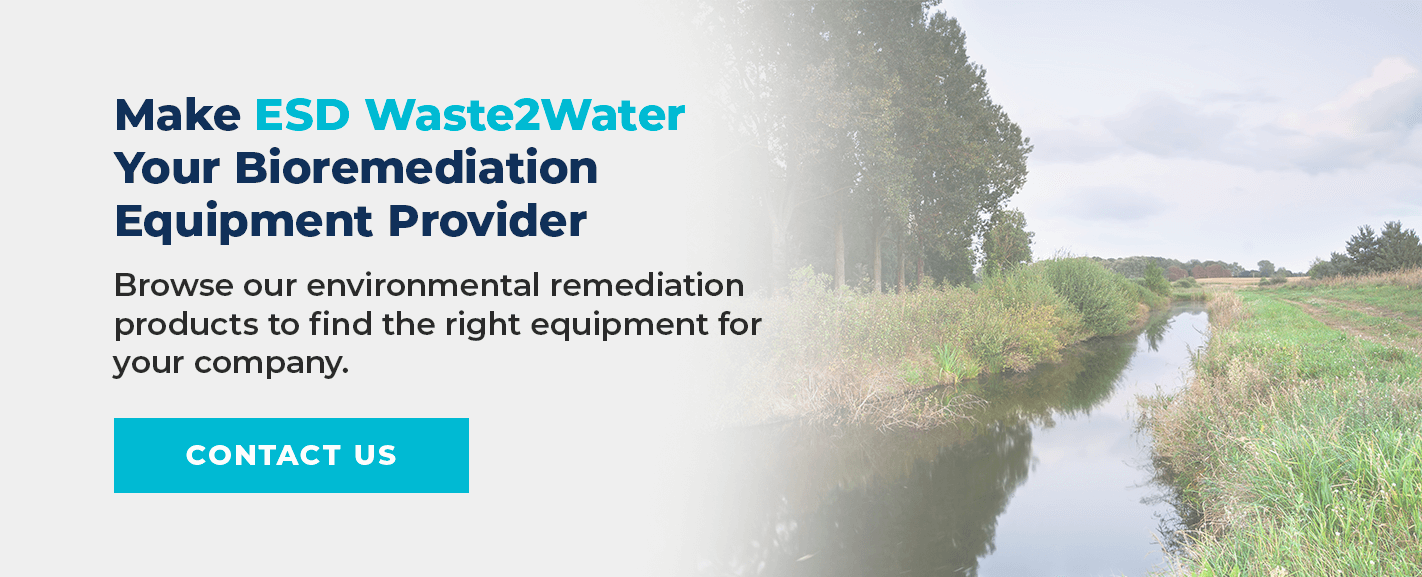Jump to:
What is Bioremediation | How Bioremediation Works | Bioremediation Classes | Strategies of Bioremediation | Bioremediation Examples | Benefits of Bioremediation | Equipment for Bioremediation
Microbial bioremediation is an eco-friendly natural cleaning process enhanced with specialized equipment. This wastewater management method removes contaminants from soil and groundwater that industrial processes produce. Using microorganisms to decompose contaminants, bioremediation is an economical way to reduce pollution and keep groundwater clean.

Using the right specialized bioremediation equipment can enhance natural groundwater cleaning to accelerate the process and return groundwater and soil to the environment quickly and safely. Learn more about the bioremediation process and how specialized equipment can benefit companies.
What Is Bioremediation?
Bioremediation is an environmental process that cleans contaminated groundwater and soil. This process enhances natural biological actions to remove contaminants from used water.
Industrial processes such as mining, agriculture and manufacturing produce various byproducts. Some resulting inorganic and organic residual compounds are harmless, but others can be toxic and harm the environment. Toxic residual compounds are especially harmful to groundwater and soil. The planet has existing environmental remediation systems, but natural soil and groundwater remediation processes take time.
Bioremediation technology reclaims polluted water and soil so it can safely return to the environment after people use it in industrial practices. Some waste management processes use remediation equipment to remove and dispose of pollutants, but the bioremediation process uses live organisms to remove or neutralize pollutants in contaminated areas.
Biological microbes are microscopic bacterial organisms that naturally exist in the environment. These microorganisms exist naturally to help decompose, recycle and rectify imbalanced groundwater and soil chemical conditions. Nature uses bacterial microorganisms to correct itself when human practices cause damage. Bioremediation is a scientific process that applies natural organic substances and their beneficial properties to remediate contaminated groundwater and soil.
The Biological Remediation Process – How Does Bioremediation Work?
According to the Environmental Protection Agency, the bioremediation process is a water and soil treatment technique using natural organisms to attack toxic materials and change them into safer substances. Significantly contaminated areas can often become toxin-free using the right bioremediation methods and specialized equipment.
Bioremediation stimulates natural microbes to consume contaminants as their energy and food source. Certain microorganisms eat toxic chemicals and pathogens, digesting and eliminating them by changing their composition into harmless gases like ethane and carbon dioxide. Some contaminated water and soil conditions already have the right counter-microbes to eliminate contaminants naturally, but human intervention can boost microbial action and accelerate nature’s remediation process.
In some cases, microbes are absent or sparse. In these situations, the bioremediation process adds amendments, which are microbial actors such as aerobic bacteria and fungi. These microbial substitutions mix with water or soil to rectify conditions rapidly in the proper environmental conditions. Bioremediation requires the following critical conditions:
- Host microbial contaminants: Host microbial contaminants provide fuel and energy to parasitical microbes.
- Parasitic microbes: Parasitic microbes feed off their harmful hosts and destroy them.
- Oxygen: A sufficient amount of oxygen supports the aerobic biodegradation process.
- Water: Water must be present in liquid form or in soil moisture content.
- Carbon: Carbon is the foundation of microbial life and its energy source.
- Temperature: The temperature must be within the right range for microbial life to flourish, so it cannot be too cold or too hot.
- Nutrients: Nutrients such as nitrogen, phosphorous, potassium and sulfur support microbe growth.
- Acid and alkaline proportions: Acid and alkaline proportions must have a pH ratio ranging between 6.5 and 7.5.
With the right conditions, microbes can grow at significant rates. In imbalanced conditions, microbial action can end or slow down, leaving contaminants in the environment until natural processes restore balance. Re-balancing can take a long time in highly polluted conditions, but proper treatment processes can rectify most situations in a relatively short time.
Oxygen has a strong effect on bioremediation. Some microbes thrive on oxygen while others are hindered when exposed to excessive oxygen. This effect depends entirely on what particular toxin the process is remediating and what type of microbe it is encouraging. Water and soil oxygen levels can be controlled with the following processes:
- Aerobic: The aerobic process presents the oxygen needed for microbial development. In contaminated soil conditions, regularly tilling the soil is one aerobic enhancement method. This technique is also the main activity in composting to oxygenate helpful fungi. Aerobic action is also introduced mechanically through passive bioventing or by forcing compressed air into the soil or under the water table with biosparging.
- Anaerobic: The anaerobic process removes or reduces the oxygen level in water or soil. This bioremediation form is uncommon, except in heavy metal conditions such as mitigating sites polluted by polychlorinated biphenyls or trichloroethylene. Anaerobic remediation is a specialized form requiring advanced techniques and precise monitoring.
Bioremediation Classifications
There are two main classifications of bioremediation. This refers to where remediation is carried out, not the actual bioremediation technique classes. Bioremediation can occur in one of two locations depending on the following methods:
In Situ
When bioremediation occurs in situ, all the process work takes place at the contamination site. This site can be in polluted soil that’s treated without unnecessary and expensive removal, or it can be in contaminated groundwater that’s remediated at its point of origin. In situ is the preferred bioremediation method, as it requires far less physical work and prevents people from spreading contaminants by pumping or moving them away to other treatment locations. Bioventing, biosparging and bioaugmentation are the main technique classes.
Ex Situ
Ex situ means removing contaminated material from one location and moving it to a remote treatment location. This classification is less common. It involves excavating polluted soil and trucking it offsite. In the case of contaminated water, ex situ is rare, except for pumping groundwater to the surface and biologically treating it in an enclosed reservoir. Ex situ bioremediation poses a hazard because it can spread contamination or risk an accidental spill during transport.
Bioremediation Technique Classes
Bioremediation technique classes are the prescribed physical activities or strategies used in microbial remedies. The overall process starts with isolating contaminated site conditions and characterizing what resident microbes exist. Scientists watch how these microbes already interact with the pollutants, then conduct lab testing to map out colonization requirements.
Catabolic activity is studied in the lab, from which a field plan is developed. Once that’s implemented, the bioremediation process is monitored, and adjustments are made as necessary.
For ex situ treatment, three technique classes can be applied. One is landfarming, where the soil is spread and biologically decontaminated. Another is composting, which is an age-old process. The third class involves biopiles. Biopiling is a hybrid process of stacking material in silos, then composting as a biological treatment.
Bioremediation Strategies
Bioremediation strategies are plans outlining how to carry out the fieldwork. Different technique applications depend on the site’s saturation degree and what type of contaminants need removal. Techniques also depend on site conditions such as soil composition, compaction, groundwater tables and runoff characteristics. The best technique for a situation also depends on whether the contaminated material requires in situ work or ex situ removal.
Thanks to today’s advanced technology, most polluted properties can be treated onsite. There are three main bioremediation strategies, each with individually designed equipment. The three applications are the following:
- Bioventing: Bioventing is the most common bioremediation approach. This process involves drilling small-diameter wells into the soil that allows air ingress and passive ventilation where ground gases produced by microbial action are released. People can use this approach for groundwater and soil complications because it adjusts the vent rate, which controls nutrient and oxygen rates.
- Biosparging: Biosparging involves high-pressure air injection forced into the soil or under the groundwater table. This process increases oxygen concentration and enhances biological Air sparging is highly effective and affordable, compared to excavating and tilling contaminated soil or circulating polluted water through pumps and filter tanks.
- Bioaugmentation: Industries often use bioaugmentation to add extra exogenous species or indigenous microbes to industrial sites. Augmentation works in conjunction with both bioventing and biosparging applications, but it has limitations. Non-indigenous microbes are not usually compatible with indigenous bacteria, so many of the bioaugmentation additives are additional microbes to those already at work.
Other bioremediation strategies for contaminated soil and groundwater sites can also be implemented. Oil and petroleum waste pollute many areas. Methane is another significant pollutant produced by biological action. Most regulatory bodies are strict about adding other pollutants into the environment, which is a side problem for the bioremediation process.
Oil is lighter than water and notoriously floats on the surface, creating a hazard for runoff and secondary pollution. Methane gas is odorous when released in large quantities. This frequently happens when contaminated soil is stirred, but passively occurs through bioventing and biosparging. Companies can control bioremediation side effects with the following techniques:
- Oil/water separators: Oil and water separators skim surface petroleum pollutants and separate them for containment and recycling. Decontaminated water is then recirculated back on the site.
- Air strippers: Air strippers pull air from the soil and clean it before releasing it back into the atmosphere. This remediation assistance prevents polluted air from escaping the soil into areas that cannot contain it.
- Soil vapor extraction: Soil vapor extraction is a process that collects contaminated gases from the soil and dissipates them through mechanical devices. This technique often occurs alongside biosparging. Like oil water separators and air strippers, soil vapor extractors are specialized pieces and require experienced operators.
Bioremediation Examples and Uses
Bioremediation has become America’s primary contaminated site recovery method, and it is commonly implemented worldwide in various situations. Bioremediation is beneficial anywhere human activity damages a location and leaves it unusable without intervention.
America’s population continuously grows, reducing the amount of landfill space that can hold polluted material. Bioremediation is an economical solution that can reduce pollution.

A broad range of organic and inorganic compounds make up the pollutants in contaminated water and soil. Contaminants also include bacteriological and even radioactive parameters. Common uses for bioremediation intervention include the following site types:
- Petroleum stations: The underground tanks in petroleum stations can corrode, allowing gasoline and diesel fuel to leach into the ground and remain long after the station’s service life expires. Petroleum products are particularly receptive to bioremediation.
- Industrial sites: Some industrial sites use chemicals in production, and these chemicals can spill or discharge. Heavy metals like lead and chromium are tough to remediate, but many lesser pollutants are biologically neutralized.
- Landfills: Overfilled, leached or decommissioned landfills are well-suited to bioremediation. Methane gas is a common landfill byproduct, but it can be controlled through air stripping and scrubbing.
- Farms: Over-fertilizing frequently occurs on farms, making them excellent candidates for bioremediation. Over-fertilization includes chemical fertilizers and animal waste products.
- Lumber processing yards: Wood preservatives often pollute lumber processing yards. They commonly leach into the soil and groundwater, but bioremediation efforts can remove these pollutants.
- On-site sanitation systems: On-site sanitation systems can contaminate soil and groundwater when septic tanks and disposal fields fail. These sanitary system overflows are highly responsive to biological treatment.
- Mine site tailings: Mine site tailings can be extremely toxic. Bioremediation efforts have proved very successful in detoxifying old mine quarries and pits.
- Accidental chemical spills: Chemical spills alongside transportation routes have been remediated through biological treatment. This includes petroleum discharges and even road salts.
Advantages of Bioremediation
Biorememdiation’s most significant benefit is its environmental contribution. The bioremediation process allows nature to repair itself with help from experienced people and specialized equipment. Since it’s a primarily natural process, it is the least invasive and safest groundwater and soil cleaning method. Bioremediation can remove contaminants such as the following:
- Fluoride
- Pathogens
- Arsenic
- Nitrate
- Metals
- Volatile organic compounds
- Pollutants such as phosphates and ammonia
- Insecticides
- Herbicides
- Saltwater intrusion
Bioremediation can effectively clean these contaminants from groundwater and soil. The benefits of bioremediation include the following:
- An eco-friendly solution: Bioremediation is an entirely natural process with little to no damaging side effects.
- In situ application: Most bioremediation applications can occur in situ, eliminating the risk of dangerous transport.
- Quick turnaround time: With bioremediation, soil and water can return to being useful faster than with other cleaning methods.
- Minimal equipment requirement: The bioremediation process requires minimal equipment.
- Positive reputation: Since it is a natural process, bioremediation is a publicly acceptable process.
- Cost-effectiveness: Implementing the bioremediation process is an economical solution, and its maintenance needs are cost-effective.
- Decreased liability: When companies implement bioremediation, contaminants are less likely to escape. This lowers a company’s liability.
- Energy efficiency: Bioremediation consumes less energy compared to landfilling and incineration.
- Official approval: Regulatory authorities accept bioremediation and hold it in high regard.
Specialized Bioremediation Equipment
Specialized bioremediation equipment is available. Most bioremediation equipment is easy to use, but some of it requires skilled operation by trained individuals. Specialized bioremediation equipment typically costs less than the heavy trucks and machinery necessary for soil excavation. The bioremediation process also eliminates the need for reservoirs and pumps. To clean industrial and commercial sites, companies need the following specialized bioremediation equipment:
- Soil and groundwater remediation systems: Soil and groundwater remediation systems offer fully integrated, pre-wired and pre-piped turnkey operations that are factory tested and ready to use in the field. They’re available with air sparging, biosparging and soil vapor extraction systems. These systems also handle air stripping, and oil-water Complete systems are mounted on exposed or enclosed trailers. They can also be custom-designed to specific needs. Soil and groundwater remediation systems are the latest in bioremediation technology.
- Fully integrated custom environmental remediation systems: Fully integrated custom environmental remediation systems go a step beyond. They set the standard for the entire industry. These complete custom-built systems include standard air sparging and soil vapor extraction. There are dual-phase extraction systems with thermal catalytic oxidizers, along with liquid and vapor-phase carbon adsorption.
- Dual-phase recovery systems: Dual-phase recovery systems fill the gap. They do two jobs in one by using a vacuum blower and a moisture separator. Gauges, NEMA IV control panels and lever controls can be custom-designed to exacting specifications. Options include filter vessels, oxidizers and manifolds with flow indicators. These can be conveniently trailer-mounted.
- Soil-vapor extraction systems: Soil-vapor extraction systems include a blower and vacuum pump. All components are fully integrated with marine-grade aluminum skids. They can also be mounted on an enclosed trailer to protect the investment.
- Air sparging systems: Air sparging systems contain a compressor and blower. Heat exchangers are available if required. All controls, gauges and indicators can be custom-ordered and designed to individual needs.
- Low-profile air strippers: Low-profile air strippers have a turbo tray design. They’re high-performance and low-maintenance.
- Air/water separators: Air/water separators are structurally sound to withstand full vacuum applications. They’re corrosion-free and can be used in any site condition.
- Enhanced oil/water separators: Enhanced oil/water separators are used above the ground for surface spill cleanup.
- Mobile dewatering aerators: Mobile dewatering aerators efficiently remove hydrocarbons at flow rates up to 500 GPM.
Make ESD Waste2Water Your Bioremediation Equipment Provider

Bioremediation is a natural process enhanced with specialized equipment. Natural bioremediation is a slow process, but using specialized equipment can accelerate it to release groundwater and soil back into the environment safely and quickly. ESD Waste2Water provides high-quality bioremediation equipment to help companies clean their industrial sites and have a positive impact on the environment.
ESD Waste2Water is a worldwide leader in environmental remediation and industrial wastewater treatment equipment. We design and manufacture cutting-edge technology environmental protection equipment at our factory in Central Florida. We also install, service and train customers in safe and responsible methods of biologically protecting the earth and water.
Our wastewater systems and wastewater recycling team help companies choose the right bioremediation equipment for various contamination sites. We can also custom-design any piece a company requires, and we can custom-build a complete system. We also provide technical support and preventive maintenance packages to help companies remain in business.
Browse our environmental remediation products to find the right equipment for your company. If you have specific equipment needs, inquire about our custom design services. Contact EDS Waste2Water today at 1-800-277-3279 or online.

